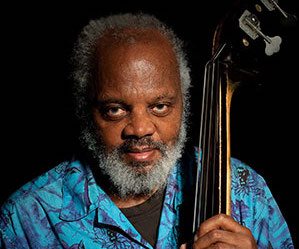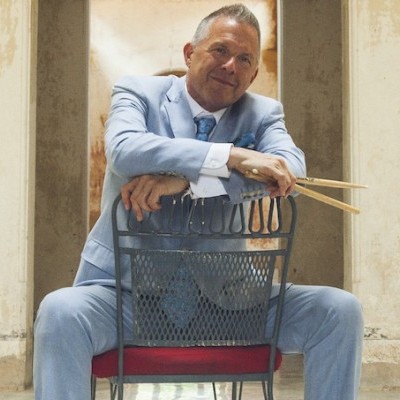Oct 28, 2025 10:47 AM
In Memoriam: Jack DeJohnette, 1942–2025
Jack DeJohnette, a bold and resourceful drummer and NEA Jazz Master who forged a unique vocabulary on the kit over his…

Henry Grimes
(Photo: Nick Ruechel)The publicist’s email promised much: A trio concert at New York venue The Stone featuring legendary bassist Henry Grimes, piano scholar Dave Burrell and innovative 32-year-old drummer Tyshawn Sorey. Grimes’ remarkable resurgence is well documented. Every line on his weathered face, the bulbous, vacant eyes scanning some great unknown (or haunted past), and the ease with which he transferred his mastery from upright bass to violin to poetic enunciations were all testament to a life of great highs and great lows.
Burrell established his career with 1960s recordings with Pharaoh Sanders, Marion Brown and Archie Shepp; his work with The 360 Degree Music Experience, David Murray and his solo recordings further revealed his mastery. Sorey was a perfect fit for this trio, his flowing muscularity and inventive drum-set colorations recently enlightening the music of Dave Douglas, Vijay Iyer and Steve Lehman as well as his strong solo albums.
After the music took off The Stone, it never stopped. Songs were not announced per se. Internal cues grounding the trio (even as beginnings) were vague. Neither were rhythm nor melody easily recognizable, but they were defined, like lightning flashes preceding an electrical storm. Kinetic ideas flew over the players’ churning patchwork, then quickly expired or changed shape. The joy in these slivers was contagious.
Rhythms were traded cooperatively: Grimes held the ballast, and thus the ultimate command, his lean lines streaming incessantly as if from a pure undisturbed source, the sound of his hands running from the bass’ upper and lower registers like free associations coursing through the tiny concert space. Sorey was a constant revelation. In one solo, he even incorporated a squeaking bathroom door (located behind him) against a brushed snare drum rhythm for a kind of call and response.
The Stone’s tightly packed audience held close to every bend in the trio’s mountainous improvisations, from ecstatic moments of twinkling sounds dotting the music’s surface to surging movements of collective faith; from group sparks that shocked with their freshness to amorphous washes of color that groaned and heaved.
The trio’s individual colorations were just as striking—you could spend the night burrowing into Burrell’s stately romanticism or Sorey’s often humorous punctuations or Grimes’ sinewy perambulations. Conversely, you could simply ride the waves, enjoying each musician’s energies from moment to moment. When every player on a bandstand creates a distinct universe, it’s hard to choose between cerebral spheres: Individual and group messages merge into one, equally compelling, equally entrancing.
During breaks in the music, Grimes picked up a paper and read aloud: “Strength that sleeps in slumber/ Makes the mind shiver/ Dancing through the mist,” and later, “Primordial beings made of blood/ Born of blood together/ Many worlds/ All pass us.” He’d play his violin just as unexpectedly, making it belch and scream, sneer and slide. You had to wonder, “What is Henry Grimes thinking?”
The trio demonstrated tremendous flexibility. After crescendos, things would break down, then speed up again, like someone manipulating a tape machine. Burrell’s melodies recalled folk music, Beethoven, Tchaikovsky and Cole Porter. One moment you felt as if you were in a cathedral, and the next, in the desert scanning the stars.
Sorey’s inventions were equally varied, his Hulk-like body striking drums with sticks, brushes, hollow tubes, multi-rods, his palms, his fingers—slapping, spattering, stoking. Grand bass solos merged into regal piano chords and drum rhythms that recalled glacial movements. At times everything moved as slowly as a dirge, then swung and then exploded. It was delirious yet exhausting. Then it was over.
Concerts such as these are often impossible to accurately document. They’re better left to legend and memory, like a tale of hardship ultimately overcome. Grimes’ life has careened from success to desperation and finally—as this concert revealed—to freedom. DB

Jack DeJohnette boasted a musical resume that was as long as it was fearsome.
Oct 28, 2025 10:47 AM
Jack DeJohnette, a bold and resourceful drummer and NEA Jazz Master who forged a unique vocabulary on the kit over his…

Always a sharp dresser, Farnsworth wears a pocket square given to him by trumpeter Art Farmer. “You need to look good if you want to hang around me,” Farmer told him.
Sep 23, 2025 11:12 AM
When he was 12 years old, the hard-swinging veteran drummer Joe Farnsworth had a fateful encounter with his idol Max…

D’Angelo achieved commercial and critical success experimenting with a fusion of jazz, funk, soul, R&B and hip-hop.
Oct 14, 2025 1:47 PM
D’Angelo, a Grammy-winning R&B and neo-soul singer, guitarist and pianist who exerted a profound influence on 21st…

Kandace Springs channeled Shirley Horn’s deliberate phrasing and sublime self-accompaniment during her set at this year’s Pittsburgh International Jazz Festival.
Sep 30, 2025 12:28 PM
Janis Burley, the Pittsburgh International Jazz Festival’s founder and artistic director, did not, as might be…

Jim McNeely’s singular body of work had a profound and lasting influence on many of today’s top jazz composers in the U.S. and in Europe.
Oct 7, 2025 3:40 PM
Pianist Jim McNeely, one of the most distinguished large ensemble jazz composers of his generation, died Sept. 26 at…